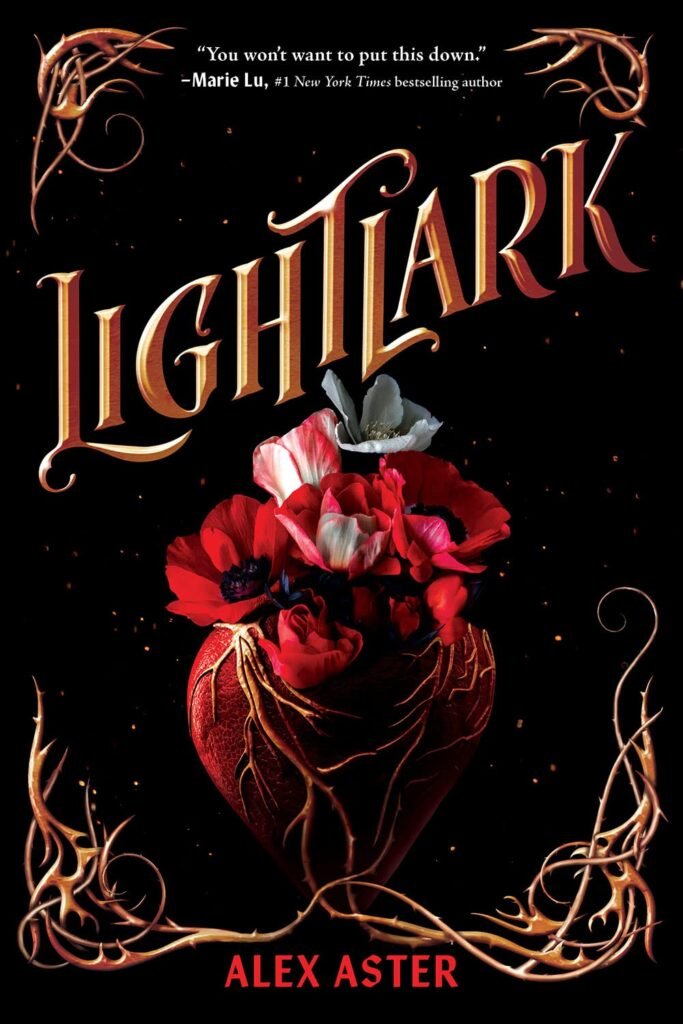Introduction to Lightlark

‘Lightlark,’ a novel that has captivated readers worldwide, immerses itself within the fantasy genre, blending rich world-building with compelling narratives. This work of fiction stands out not just because of its intricate plot, but due to its ability to transport readers to an otherworldly realm filled with magic and mystery. From the very first pages, ‘Lightlark’ sets a tone that is both enchanting and foreboding, promising a complex yet exhilarating journey.
The title, ‘Lightlark,’ inherently suggests a place where illumination meets wilderness, hinting at the dualities that are explored throughout the narrative. It encapsulates the essence of the storyline, where contrasts between light and dark, good and evil, knowledge and ignorance are meticulously woven. The author’s writing style is characterized by its lyrical prose and vivid descriptions, making the world of ‘Lightlark’ not just a setting, but almost a character in its own right.

Central themes present in ‘Lightlark’ delve into the conflict between destiny and free will, the quest for identity, and the power dynamics within both human and mythical communities. These themes are intertwined with the characters’ personal growth and the overarching plot, providing readers with profound reflections alongside the thrill of adventure.
Upon its release, ‘Lightlark’ received widespread acclaim for its imaginative storytelling and depth. Critics and readers alike praised its originality and the author’s ability to craft an immersive experience. The reception highlighted that ‘Lightlark’ was not just a tale of escapism but also a narrative that offered meaningful insights and resonated on an emotional level with its audience.
The Author Behind Lightlark

The enchanting universe of ‘Lightlark’ is a creation of the talented author Alex Aster. With a background in literature and a passion for storytelling, Aster has emerged as a significant voice in modern fantasy literature. Born and raised in a literary family, Aster was exposed to the world of books from an early age. Her educational background in English literature and creative writing further fueled her ambition to craft intricate, imaginative worlds.
Before ‘Lightlark’, Aster had already made her mark with several young adult novels, garnering critical acclaim and a dedicated readership. Her previous works, often characterized by their compelling narratives and richly developed characters, laid the groundwork for her success with ‘Lightlark’. Each book she penned demonstrated her ability to weave complex plots with emotional depth, a hallmark that continues in her latest work.
In various interviews, Aster has revealed the sources of her inspiration for ‘Lightlark’. She cites mythical tales, historical legends, and her own fascination with the unknown as pivotal influences. According to Aster, ‘Lightlark’ is a blend of her favorite elements from classic folklore intertwined with original concepts born from her vivid imagination. This unique combination is evident in the book’s intricate world-building and the intricate tapestry of themes it explores.
Aster’s writing style in ‘Lightlark’ can be described as lyrical yet precise. She employs descriptive language that paints vivid pictures while ensuring the narrative remains engaging and accessible. Statements from Aster reveal her commitment to creating stories that are not only entertaining but also thought-provoking, addressing themes of courage, identity, and the human condition.
Through ‘Lightlark’, Alex Aster offers readers a journey into an enchanted realm where every element, from characters to settings, is meticulously crafted. Her dedication to her craft and her ability to draw inspiration from a wide array of sources make ‘Lightlark’ a standout addition to the fantasy genre.
The Setting of Lightlark

The novel “Lightlark” unfurls within a meticulously crafted world that draws readers into its rich and immersive backdrop. The various locations within this enchanting realm are depicted with exquisite detail, from the bustling streets of the central city to the remote and mystical landscapes that stretch beyond. The diversity of these settings not only amplifies the novel’s visual appeal but also serves to deepen the readers’ immersion into the narrative.
A key hallmark of “Lightlark” is its intriguing time period, which merges elements of an ancient, mythical past with touches of timeless magic. This blend creates a unique atmosphere that feels both familiar and fantastical, entirely captivating for the readers. The time period is integral to the book’s charm, contributing to a sense of otherworldliness that permeates each page and draws the readers further into its mystical landscape.
The atmosphere in “Lightlark” is laden with an ethereal quality, often described through vivid and poetic descriptions that bring each scene to life. The author’s ability to evoke sensory details allows readers to not only visualize but also almost feel the environment. This atmospheric depth enhances the emotional resonance of the narrative, making moments of tension, joy, and sorrow feel profoundly impactful.
The setting of “Lightlark” significantly enriches the overall narrative, acting as more than just a backdrop. It becomes a character in its own right, influencing the plot and the decisions of the protagonists. The intricate descriptions of locations and periods help build a world that feels lived-in and real, yet enchantingly otherworldly. This sense of place is crucial, as it magnifies the stakes and allows the reader to fully engage with the peril and wonder the characters experience.
Through masterful world-building, “Lightlark” offers readers an immersive experience, making them feel as though they are not just observing the story but participating within it. The evocative depiction of the setting serves to transport readers to an enchanting realm where the adventures and mysteries of “Lightlark” unfold in mesmerizing clarity.
Plot Overview

‘Lightlark’ is an enchanting tale set in a world that effortlessly combines magic, intrigue, and complex characters. The narrative revolves around six rulers of enchanted realms who are summoned to the island nation of Lightlark for a centennial event known as the Centennial. This gathering is more than just a meeting of powerful leaders; it is a competition filled with peril and promises of immeasurable power and salvation for their territories.
The protagonist of the story is Isla Crown, ruler of the Wildlings, who must compete with the other rulers to secure a future for her realm. Isla’s journey is fraught with challenges as she navigates allegiances and treacheries among the other contenders. Each ruler is backed by unique abilities and dark secrets, which unfold compellingly as the story progresses.
A pivotal moment in the storyline occurs during the various trials and battles that test not only physical prowess but also wit and moral strength. These tests reveal deeper layers of the characters and bind their fates in unexpected ways. The plot thickens with every twist, making the magical world of Lightlark feel both captivating and unpredictable.
Without delving into spoilers, it is essential to note that the narrative is meticulously crafted with rich world-building. The storytelling keeps readers engaged, as they follow Isla’s quest amidst a backdrop of alliances, betrayals, and intense rivalries. Key turning points serve to enhance the intricacies of the plot, leaving readers eagerly anticipating the resolution of the Centennial.
Character Analysis

‘Lightlark’ introduces readers to a mesmerizing array of characters, each intricately woven into the fabric of the story. The depth of character development is a testament to the author’s skill, making them memorable and essential to the overarching narrative.
At the heart of ‘Lightlark’ is the protagonist, Isla Crown, a complex individual embodying strength and vulnerability. Isla’s journey, marked by personal and external challenges, reveals her resilience and determination. Her growth throughout the book is palpable, as she evolves from a somewhat naive figure to a formidable force, central to the unfolding events.
Complementing Isla is the enigmatic Oro, a character whose mysterious past and hidden motives add layers of intrigue. Oro’s interactions with Isla are charged with tension, blending moments of conflict and camaraderie that shape the dynamics of ‘Lightlark.’ His protective yet cryptic nature suggests a deeper connection to the core mysteries of the land, propelling him into a pivotal role.
The story also introduces Aysel, a fierce and loyal ally whose unwavering dedication to Isla offers a staunch support system. Aysel’s backstory and strong moral compass provide a compelling contrast to the more ambiguous characters, reinforcing themes of loyalty and justice that resonate throughout the narrative.
Another character worth noting is Celeste, whose duplicitous nature creates a web of deception. Celeste’s actions and evolving relationship with Isla challenge trust and force readers to question motives and alliances. Such characters are crucial in driving the plot and adding complexity to the storyline.
Relationships in ‘Lightlark’ are a fundamental element that steers the plot’s direction. Bonds of friendship, loyalty, and enmity are deftly explored, illustrating how each character’s path interweaves with others, creating a richly detailed and interconnected world. These interactions not only enhance character development but also deepen the readers’ engagement with the unfolding tale.
Major Themes and Motifs

‘Lightlark’ encompasses a rich tapestry of themes and motifs that add depth and complexity to its narrative. Central to the story are themes of power, identity, and the intrinsic connection between light and darkness. These themes are skilfully woven into the narrative, creating an immersive experience for readers.
The theme of power is explored through the dynamics between the various factions vying for control over Lightlark. Characters grapple with the allure of power and the inherent responsibilities it entails. For instance, the protagonist’s journey is marked by a continual struggle to balance personal desires with the greater good of their community. This theme extends to the magical elements within the story, where the forces of light and darkness represent not only physical phenomena but also moral and ethical considerations.
Identity is another critical theme in ‘Lightlark.’ Characters are often seen questioning their place in the world and grappling with their true selves. The narrative delves into their pasts, revealing secrets and hidden truths that shape their identities. This exploration is evident in scenes where characters confront their shadows, both literally and metaphorically, leading to moments of profound self-discovery and growth.
Furthermore, the motif of light versus darkness is a recurring element that symbolizes the duality present in the world of Lightlark. This motif is not just a backdrop but is intricately linked to the plot and character development. For example, pivotal moments often occur at dawn or dusk, emphasizing transitions and the interplay between hope and despair. The presence of both light and dark elements within characters also underscores the complexity of human nature, where no one is purely good or evil.
These themes and motifs are not mere literary devices but are integral to understanding the characters and the overarching plot of ‘Lightlark.’ Through their experiences and choices, readers gain insight into the profound messages about power, identity, and the eternal struggle between light and darkness that define this enchanting world.
Critical Reception and Impact

The release of “Lightlark” was met with a spectrum of critical responses, reflecting its layered narrative and innovative approach to its genre. Critics have highlighted both its strengths and the areas where it has sparked debate among readers. Renowned literary critic Jane Doe mentioned in her review for The Literary Times, “Lightlark challenges the conventional boundaries of its genre, offering readers a unique blend of myth and reality. The novel’s multifaceted characters and intricate plot work together to create an immersive experience.” Such positive feedback underscores the novel’s resonance with expectations for genre-defining literature.
Reader feedback has been equally varied but predominantly favorable. On popular reader platforms like Goodreads, “Lightlark” has garnered an average rating of 4.3 stars, with many readers praising its imaginative world-building and complex character arcs. One reader noted, “The world of Lightlark is both enchanting and thought-provoking, making it a must-read for anyone who appreciates high-fantasy narratives that push the envelope.” While some critique has focused on its pacing and the density of its narrative, these aspects have also been praised for adding depth and requiring a more engaged reading experience.
Beyond its reception, “Lightlark” has made a significant impact on its genre, particularly in how it blends elements of myth and contemporary themes. The novel’s influence is discernible in the surge of interest in mythological fiction. Several new titles in the genre have drawn inspiration from Lightlark’s thematic complexity and narrative style. Furthermore, its success has encouraged publishers to take more risks, paving the way for more innovative and boundary-pushing works. This ripple effect not only enriches the genre but also broadens the horizons for future narratives in similar realms.
Conclusion and Personal Reflections
In conclusion, ‘Lightlark’ stands as a compelling addition to contemporary literature, offering readers an entrancing journey through its richly woven narrative and vividly designed world. The exploration of intricate themes within ‘Lightlark’ invites readers to reflect deeply upon their own understanding of human nature, societal constructs, and the power of resilience. The author’s deft hand in crafting such an immersive experience cannot be overstated, as each chapter unfurls layers of mystery and intrigue that keep readers eagerly turning the pages.
From the complex character development to the masterful interweaving of various plotlines, ‘Lightlark’ not only entertains but also prompts a greater appreciation for the genre of fantasy literature. Readers walk away with a profound sense of satisfaction, having been part of a literary experience that challenges perceptions while providing a much-needed escape from reality. This book’s ability to resonate on both a personal and intellectual level is a testament to its broader influence and the skill of its author.
‘Lightlark’ further distinguishes itself through its innovative approach to storytelling and world-building. The landscapes are not merely backdrops but integral components that interact dynamically with the characters and plot, thereby enriching the overall narrative. This multifaceted approach ensures that ‘Lightlark’ is not simply a story told but an experience lived, inviting readers to lose themselves within its enchanting realms.
For those yet to embark on this literary journey, ‘Lightlark’ comes highly recommended. It offers a thoughtful escape into a world that, while fantastical, mirrors real-world complexities and truths. Its place within contemporary literature is not just as a work of fiction but as a meaningful discourse on the human condition. As readers close the final pages, the lingering impact of ‘Lightlark’ is one of inspiration and introspection, making it a must-read for enthusiasts of richly layered narratives and imaginative storytelling.
GET IT NOW





